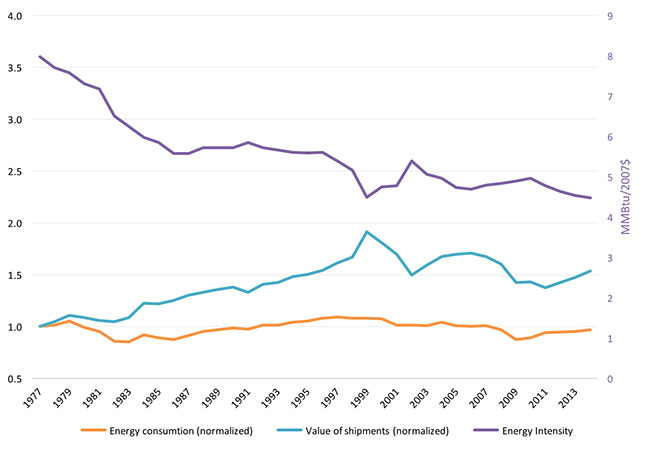The industrial sector, which includes dozens of individual industries spanning agriculture, forestry, fisheries, construction, mining, and manufacturing, accounts for about one-fifth of the US gross domestic product. Industry is unique among the end-use sectors in that its energy intensity has declined consistently over the past 35 years, as can be seen in the figure below. During this period, energy use has fluctuated within a limited range even as the sector output has grown almost 50%, and as economic activity has risen and fallen with economic cycles. Overall, industrial energy intensity declined 38% over the 1980–2013 period.
Industrial energy consumption, value of shipments, and energy intensity, 1977–2013
Source: ACEEE analysis based on various EIA sources
The graph represents a composite of all these industries. (The data for each individual industry is impractical to graph because of number, diversity, and business cycles in individual industries.) For the sector as a whole, an inverse relationship exists between intensity and value of shipments, reflecting the relationship of utilization of capacity in industry, which indicates the economic health of the sector. (“Value of shipments” measures the economic value of all products shipped from industrial plants in an industry.)
While some of this change in intensity is a result of structural shifts in the industrial sector, much of it can be attributed to technology and practice improvements in energy-intensive industries, which account for over four-fifths of the sector energy use. For example, the steel industry has made major modernization investments, which have resulted in a 28% reduction in Btus per ton of steel produced between 1990 and 2004. A large factor in this improvement has been a shift toward more reliance on secondary steel (recycled steel) and less reliance on primary steel (from iron ore through a reduction process). Importantly, this shift from primary to secondary product was enabled by the development of technology that allows the use of scrap to produce high-strength steel alloys.
Also contributing to reducing industrial energy use are system approaches, such as combined heat and power (CHP). CHP is an energy-efficient method of generating both electricity and useful thermal energy in a single, integrated system that is used in many energy intensive industries. A CHP system saves energy by recovering heat that would otherwise be wasted from power-only generation and using it to satisfy on-site thermal energy needs. The chemical industry has reduced energy use per unit of product by about 40% since 1980 by expanding CHP installations and modernizing process technology.
As the adoption of new techniques, such as smart manufacturing and intelligent efficiency, continues, so should industrial energy intensity’s downward trend.
For more national metrics on industrial energy efficiency, see The Long-Term Energy Efficiency Potential: What the Evidence Suggests and Energy Efficiency in the United States: 35 Years and Counting.
Data Points is a blog series focusing on the graphs and other images that tell the energy efficiency story.



